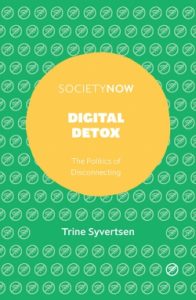In Digital Detox: The Politics of Disconnecting, Trine Syvertsen studies the politics of disconnection as a practice of resistance to the intrusion of digital technologies into everyday life, locating it within the context of neoliberal self-regulation. The book offers a highly accessible overview of the digital detox phenomenon and the politics of the attention economy, recommends Kim Harding.
Digital Detox: The Politics of Disconnecting. Trine Syvertsen. Emerald Publishing. 2019.
 We have long been familiar with alternative medicine’s use of the term detoxification, whereby total avoidance of certain foods can, it is claimed, purge the body of unspecified toxins. In the twenty-first century, however, heralded by the arrival of the smartphone and the intensified engagement with digital media that it brings, the idea of detox has also come to mean abstention from invasive media.
We have long been familiar with alternative medicine’s use of the term detoxification, whereby total avoidance of certain foods can, it is claimed, purge the body of unspecified toxins. In the twenty-first century, however, heralded by the arrival of the smartphone and the intensified engagement with digital media that it brings, the idea of detox has also come to mean abstention from invasive media.
The intrusion of digital technologies into everyday life is the backdrop to Trine Syvertsen’s Digital Detox, in which the University of Oslo Professor of Media Studies – who is currently chairing Digitox, a four-year research project on digital detox – studies the phenomenon in more detail, including the politics of disconnection and how it has become a practice of resistance for some. Setting out the book’s intention to critically examine the pressure to be online (2), Syvertsen locates the practice of digital detoxing in the context of neoliberal self-regulation.
Syvertsen asks why digital detox has emerged as a phenomenon over the past decade and argues that three historical trajectories are ‘essential to understand experiences of overload’ (6): the intensification of the attention economy; the political pressure to get everyone online; and the prevailing culture of self-optimisation, whereby in a neoliberal society, individuals are tasked with managing risks and problems. To understand digital detox practices, Syvertsen draws on three terms from media studies (9-10). These are ambivalence, whereby users of digital media are conflicted between positive and negative aspects of their digital media use; the digital labour involved in the work of abstaining from digital media; and identity, whereby one’s values and beliefs are signalled by non-use of media.
 Image Credit: ‘Old Light Switches’ by Paul Cross licensed under CC BY 2.0
Image Credit: ‘Old Light Switches’ by Paul Cross licensed under CC BY 2.0
In the second chapter, ‘What is the problem? Intensifying the quest for attention’, Syvertsen explores the mechanisms ‘employed to capture, hold and sustain attention’ (25). Here, we learn that concerns about the attention economy are nothing new. Syvertsen cites the US anti-television campaigner Marie Winn, who likened television to drugs in the late 1970s. This comparison is similar to some of the discourses surrounding digital media use over the past decade, whereby time spent online has often been framed, sometimes controversially, in terms of addiction (14). Providing more historical context, Syvertsen reports that subscription models have long served as a way by which to ‘secure predictable revenue’ – such as the serialisation of stories in nineteenth-century ‘dime’ novels (27-28). The ‘extreme indulgence’ of the Netflix binge is also offered as a more recent example (39).
Although, writes Syvertsen, the early internet did not feature much interest in audience measurement, Thomas H. Davenport and John C. Beck’s influential The Attention Economy (2001) put forward the idea that a website’s success lay in its ‘stickiness’ – its ability to attract and retain users (29). The emergence of sticky social media, argues Syvertsen, is crucial to understanding why issues of detox and disconnection have become more acute (31). Facebook’s engagement with users to build their social capital is cited as one of the main reasons for those who wish to conduct a digital detox (31). While it is easy to join Facebook, it is difficult to leave or deactivate (33), thus demonstrating the platform’s sophistication in creating a sticky web that makes exit a difficult task.
In the third chapter, ‘You are the problem!’, Syvertsen takes a look at the political forces that may explain why digital detoxing, and reactions to this trend, have emerged in the past decade. We spend more time online, she contends, because our governments want us to be online (49). Digital strategies to this effect are ‘techno-optimistic’ (55), allocating the responsibility for social problems to individuals through processes of liberalisation and deregulation (56). By way of illustration, Syvertsen uses the Fitbit watch as an example of how digital tech can make one a responsible citizen twice over, by both lowering public sector healthcare costs and also by sharing personal health data (57).
Resistance is possible, outlines Syvertsen, citing examples of how ‘invasive messages’ have been opposed, such as in France, where a law was introduced in 2017 to ensure that employees’ freedom from work emails outside work hours was protected (62). In the UK, resistance has taken a somewhat weaker form, such as the Children’s Commissioner ‘digital 5 a day’ guidelines, which ‘gives children and parents easy-to-follow, practical steps to achieve a healthy and balanced digital diet’. This, notes Syvertsen, is ‘evidently more difficult to follow than counting tomatoes and apples and clearly demands interpretive skills’ (66).
In a related example, Syvertsen references the work of the collaborative multimedia project White Spots, which ‘visualises the invisible electromagnetic cloud that we live in and offers a way out’. In the documentary that accompanies the project, the state of being offline is a commodity that certain, privileged customers are willing to pay for: for example, through digital detox holidays. This is offered as one example of how avoiding screens, and being able to, can act as a status symbol (69).
Disconnection can seem somewhat quixotic to those of us that can’t take breaks in remote cabins, such as Kevin Roose writing for the New York Times in 2019 on his ‘restorative boredom’ detox (5), a retreat that Roose likens to Walden, ‘if Thoreau periodically wondered what was happening on Alexandria Ocasio-Cortez’s Instagram story’. Moreover, few digital media users are in the privileged position of the economic elite that can delegate one’s digital tasks to others (69).
The ubiquity of digital technology means that even if one stages the performative act of detox, some level of engagement with the rejected technology remains an inevitability. Take, for example, what Syvertsen calls the ‘remarkable consistency’ of talk about digital detoxing. She notes the Norwegian screen-free week (78-79), organised by a Christian organisation, whereby participants recruit friends and colleagues through social media to participate in the event and then post about it afterwards on Facebook. Deliciously ironic is Arianna Huffington’s #nationaldayofunplugging, whereby the Huffington Post founder disseminates her call to disconnect armed with a hashtag and 2.9 million Twitter followers.
While employing a wide range of academic sources throughout, Syvertsen draws ‘especially’ on a representative survey in the Norwegian market where 55 per cent of respondents answered in the affirmative to Kantar’s rather leading question ‘do you think you are spending too much time online?’ (3). Ideally, the use of such data and the kind of knowledge it produces, and for whom, would have been problematised further. It isn’t until the final chapter of this short book that Syvertsen, in arguing that limiting digital media use can be understood as ‘a social as much as an individual project’ (101), employs her own data less implicitly than in previous chapters, using interviews from her most recent research to illustrate the social context in which digital detoxing sits. Although research is ongoing, comprising a sample of about 60 at the point the book went to press (104-105), more of this data would have been very welcome, adding much-needed empirical weight to the book’s discussions of digital resistance strategies in a neoliberal context.
Nevertheless, Digital Detox is a highly accessible overview of the digital detox phenomenon and the politics of the attention economy. I look forward to the eventual results of Syvertsen’s Digitox project, which aims to deepen academic understanding of digital media overuse and theorise it further.
Note: This review gives the views of the author, and not the position of the LSE Review of Books blog, or of the London School of Economics.







